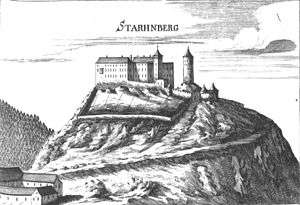Burgruine Starhemberg
| Burgruine Starhemberg | |
|---|---|
| Lower Austria, Austria | |
|
Copper engraving by Georg Matthäus Vischer, 1672 | |
 | |
| Coordinates | 47°52′03″N 16°06′07″E / 47.8675°N 16.1019444444°ECoordinates: 47°52′03″N 16°06′07″E / 47.8675°N 16.1019444444°E |
| Type | Castle |
| Site information | |
| Open to the public | Not since 2007 |
| Condition | Ruins |
| Site history | |
| Built | 1140–45 |
| Built by | Ottokar III, Margrave of Styria |
Burgruine Starhemberg is a castle in Lower Austria, Austria. Burgruine Starhemberg is 520 metres (1,710 ft) above sea level.[1]
History
The name is derived from the original name of 'high mountain' or 'Starkenberg'.
A small castle was built here by Ottokar III, Margrave of Styria between 1140 and 1145. At the time, the Piesting river was the border between Styria and the March of Austria. In 1192, Styria—and, thus, the castle—was acquired by the Babenbergs. The last Babenberger duke of Austria, Frederick II the Warlike, expanded and fortified the castle, leaving Starhemberg as one of the most important castles in Lower Austria in the 13th century. In wartime, the archives and the family treasure was hidden here, and were guarded by the Teutonic Knights.
After the Battle on the Marchfeld in 1278, the castle was acquired by the Habsburgs. In 1482, the castle was captured by Matthias Corvinus, king of Hungary. In 1683, the castle offered protection from the Turks to the surrounding population.
To escape a new roof-tax the counts of Heusenstamm around 1800 had the roof covering removed, as well as doors and window frames, beginning the decline of the castle. Around 1870, a large part of the great hall collapsed. Until the mid-20th century, the ruins were used for the extraction of construction materials by the local population.
In the spring of 1945 a unit of the Waffen-SS used the ruined tower above the chapel as an observation post. Russian artillery fire inflicted heavy damage to the walls.
In the second half of the 20th century a local organisation, Friends of the Castle Starhemberg, has sought to restore the ruins. Since 2007, the castle has been closed to visitors, for security.
-
Castle Ruin Starhemberg, contemporary south elevation
-
Castle Starhemberg's ground plan
-

Castle Ruin Starhemberg, contemporary north elevation
-
The inner bailey's southern walls
-
The castle's housing unit with domed kitchen funnel
-
The housing unit's north-eastern wall
-
The castles's inner bailey, view westward
-
The castle's western walls, view northward
